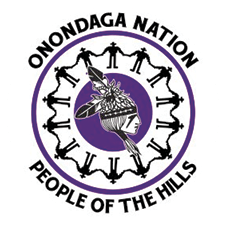

Haudenosaunee Flag
Syracuse University Libraries acknowledges, with respect, the Onondaga Nation, Firekeepers of the Haudenosaunee, the Indigenous people on whose ancestral lands Syracuse University now stands.

The Onondaga ceremonies give thanks and reflect the surrounding living world. At Onondaga we have ceremonial songs and social songs. Ceremonial songs are only performed in the longhouse and are not for public viewing. While social songs can be performed anywhere we want to be social and have lots of fun.
Dances and songs are performed in a counter-clockwise direction. The bean plant, the mother earth, the moon, and the stars; all move in this life providing direction and so do we when we dance. We consider singing and dancing as another way to give thanks. The more spirited you sing and dance, the more you show the Creator how thankful you are. In this fashion, the songs that were given to us so long ago are still being carried on today..."
To learn more about the music of the Onondaga Nation including instruments and videos of social dances with accompanying song, please continue to their website.
The Haudenosaunee Confederacy (a.k.a. Iroquois or Five Nations Confederacy) encompasses the sovereign Mohawk, Oneida, Onondaga, Cayuga, Seneca, and later the Tuscarora nations. Haudenosaunee means "people who build" or "people of the longhouse." The Mohawk are the Keepers of the Eastern Door, the Onondaga are the Keepers of the Central Fire, and the Seneca are the Keepers of the Western Door.
Haudenosaunee Confederacy
http://www.haudenosauneeconfederacy.com/
Most books on Native American music are found in the ML 3557 range, however other books are scattered based on intersectionalities with genre or study. Make sure to use various search terms when using Libraries Search or the Catalog.
Collection of print journalism from Indigenous peoples of the US and Canada from 1828-2016. From the collections at the Newberry Library, Chicago, and the Sequoyah National Research Centre at the University of Arkansas. Key topics covered include community news, public health and welfare, education, tribal laws and elections, sovereignty, and more.
Art, correspondence, diaries, business documents, manuscripts, maps, newspapers, photographs, printed books, treaties, and tribe records documenting early contacts between European settlers and American Indians, 1500-1998. Content digitized from the Edward E. Ayer Collection at the Newberry Library. Subjects covered include political, social, and cultural effects of early encounters; the turbulence of the Civil War; on-going repercussions of government legislation; and the civil rights movement.